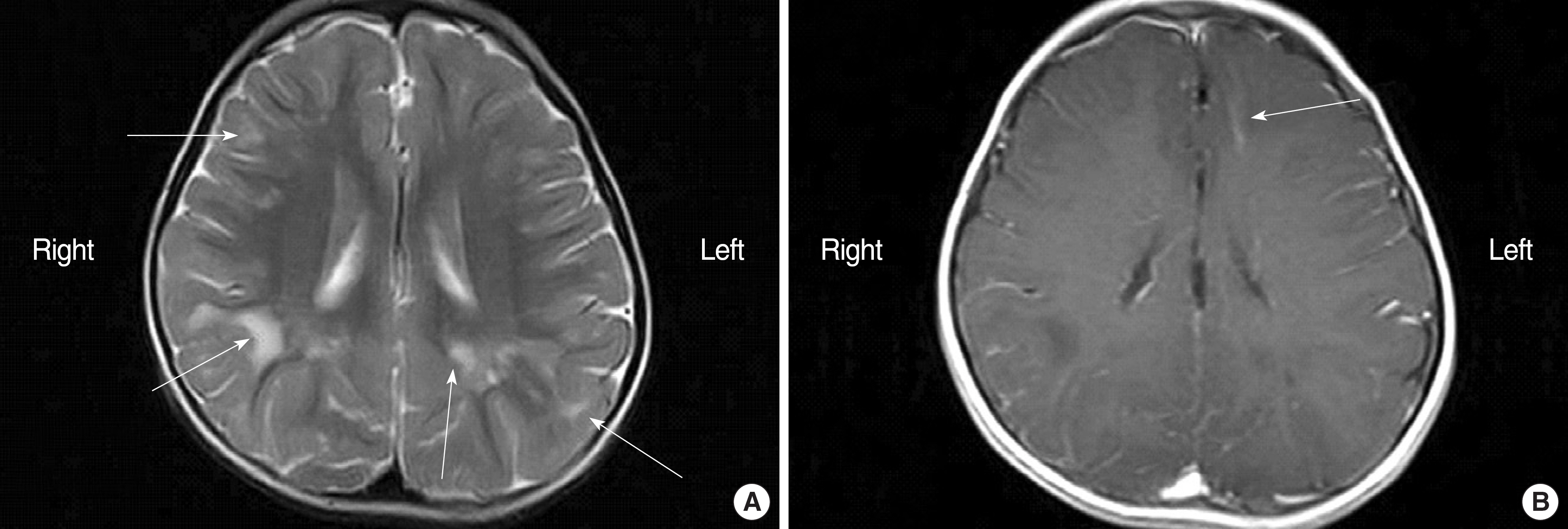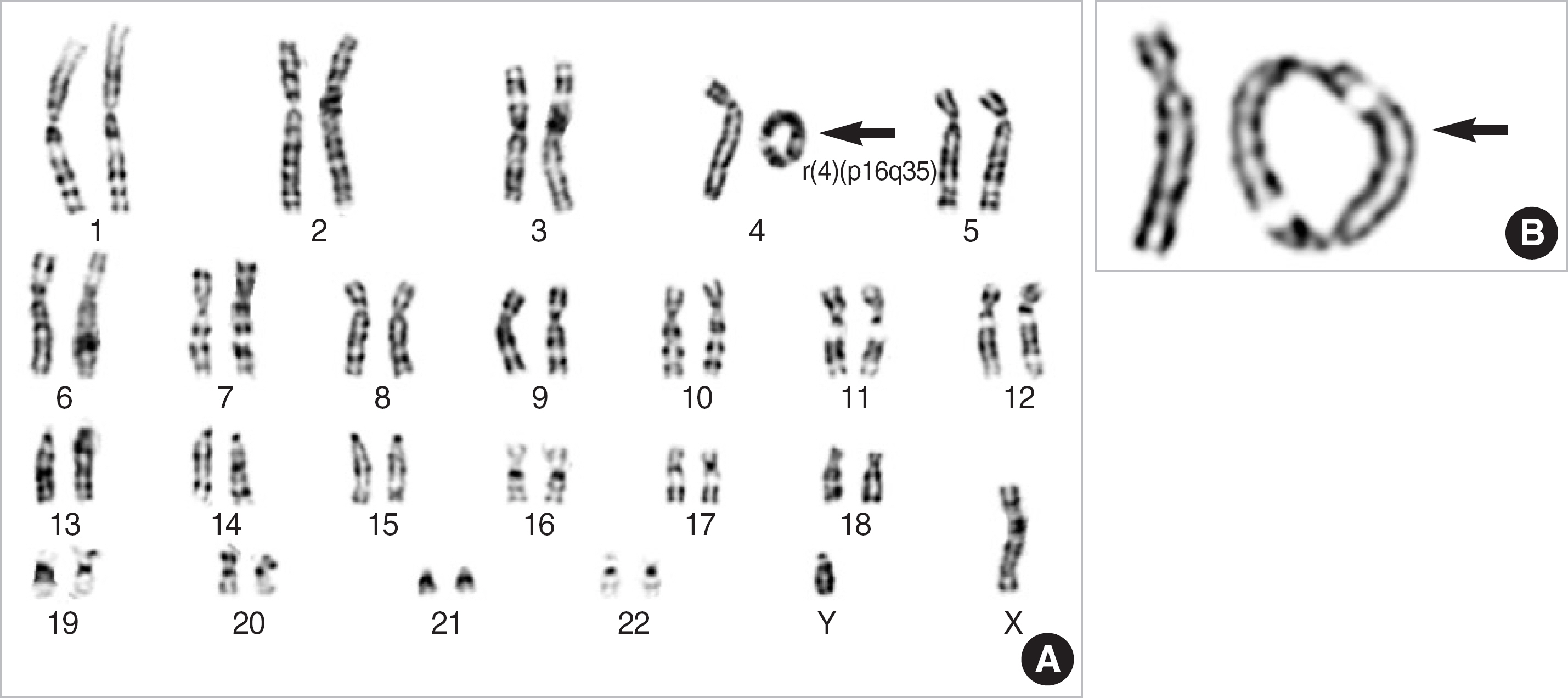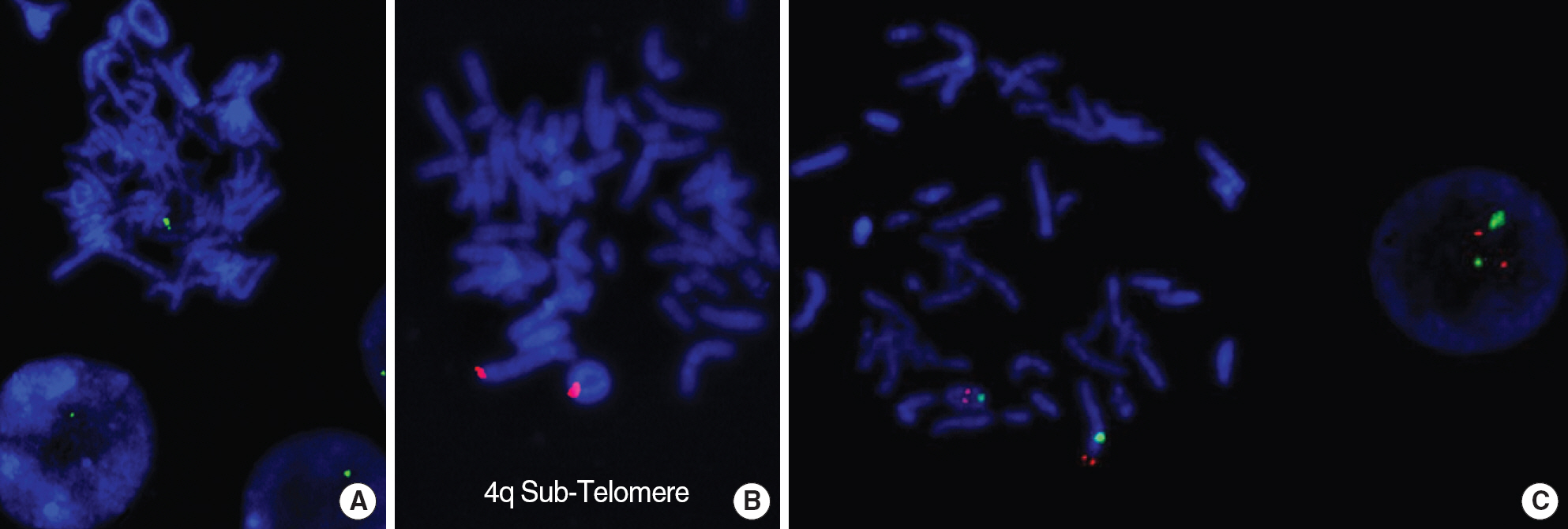Korean J Lab Med.
2009 Feb;29(1):77-81. 10.3343/kjlm.2009.29.1.77.
A Case of Mosaic Ring Chromosome 4 with Subtelomeric 4p Deletion
- Affiliations
-
- 1Department of Laboratory Medicine, Samsung Medical Center, Sungkyunkwan University School of Medicine, Seoul, Korea.
- 2Department of Pediatrics, Hallym University School of Medicine, Seoul, Korea. ohphilia@unitel.co.kr
- 3Department of Laboratory Medicine, Hallym University School of Medicine, Seoul, Korea.
- KMID: 1781598
- DOI: http://doi.org/10.3343/kjlm.2009.29.1.77
Abstract
- Ring chromosome is a structural abnormality that is thought to be the result of fusion and breakage in the short and long arms of chromosome. Wolf-Hirschhorn syndrome (WHS) is a well-known congenital anomaly in the ring chromosome 4 with a partial deletion of the distal short arm. Here we report a 10-month-old male of mosaic ring chromosome 4 with the chief complaint of severe short stature. He showed the height of -4 standard deviation, subtle hypothyroidism and mild atrial septal defect/ventricular septal defect, and also a mild language developmental delay was suspected. Brain magnetic resonance imaging showed multifocal leukomalacia. Chromosomal analysis of the peripheral blood showed the mosaic karyotype with [46,XY,r(4)(p16q35)[84]/45,XY,-4[9]/91,XXYY, dic r(4;4)(p16q35;p16q35)[5]/46,XY,dic r(4;4)(p16q35;p16q35)[2]]. FISH study showed the deletion of the 4p subtelomeric region with the intact 4q subtelomeric and WHS region. Both paternal and maternal karyotypes were normal. We compared the phenotypic variation with the previously reported cases of ring chromosome 4. The ring chromosome 4 with the subtelomeric deletion of short arm seems to be related with the phenotype of short stature.
MeSH Terms
Figure
Reference
-
1.Gardner RJ, Sutherland GR, editors. Chromosome abnormalities and genetic counseling. 3rd ed.Oxford: Oxford University Press;2004. p. 178–81.2.Shashi V., White JR., Pettenati MJ., Root SK., Bell WL. Ring chromosome 17: phenotype variation by deletion size. Clin Genet. 2003. 64:361–5.
Article3.Bergemann AD., Cole F., Hirschhorn K. The etiology of Wolf-Hirschhorn syndrome. Trends Genet. 2005. 21:188–95.
Article4.Rauch A., Schellmoser S., Kraus C., Dorr HG., Trautmann U., Altherr MR, et al. First known microdeletion within the Wolf-Hirschhorn syndrome critical region refines genotype-phenotype correlation. Am J Med Genet. 2001. 99:338–42.
Article5.Kosztolanyi G. Does “ring syndrome” exist? An analysis of 207 case reports on patients with a ring autosome. Hum Genet. 1987. 75:174–9.
Article6.Kim SS., Jung SC., Kim HJ., Moon HR., Lee JS. Chromosome abnormalities in a referred population for suspected chromosomal aberrations: a report of 4117 cases. J Korean Med Sci. 1999. 14:373–6.
Article7.Hwang SJ., Lee JH., Park IY., Moon HB., Oh JH., Lee GS, et al. A case of de novo ring (13) chromosome with deletion 13q32.2→qter. Korean J Obstet Gynecol. 2002. 45:323–6. (황성진, 이지현, 박인양, 문희봉, 오준환, 이귀세라 등. 새로 발생한 13q32.2→qter 결손과 동반된13번환상염색체환아 1예. 대한산부인과학회지 2002;45: 323-6.).8.Park YM., Nho HN., Kim SZ., Ahn YM. Cytogenetic evaluation of a patient with ring chromosome 9 presenting failure to thrive and developmental delay. Korean J Pediatr. 2008. 51:426–30. (박윤미, 노한내, 김숙자, 안영민. 성장부진과 발달지연을 보인 환아에서 확인된환상 9번 염색체 1예의 세포유전학적인 연구. Korean J Pediatr 2008;51: 426-30.).
Article9.Jung YK., Lee GH. A case of ring chromosome 20 with mental retardation and epilepsy. Korean J Pediatr. 2005. 48:108–11. (정연경및 이경훈. 정신 지체와 간질을 동반한 20 환(Ring) 염색체 증후군 1예. Korean J Pediatr 2005;48: 108-11.).10.Lee MH., Park SY., Kim YM., Kim JM., Yoo KJ., Lee HH, et al. Molecular cytogenetic characterization of ring chromosome 4 in a female having a chromosomally normal child. Cytogenet Genome Res. 2005. 111:175–8.
Article11.Blackett PR., Li S., Mulvihill JJ. Ring chromosome 4 in a patient with early onset type 2 diabetes, deafness, and developmental delay. Am J Med Genet A. 2005. 137:213–6.
Article12.Balci S., Engiz O., Aktas D., Vargel I., Beksac MS., Mrasek K, et al. Ring chromosome 4 and Wolf-Hirschhorn syndrome (WHS) in a child with multiple anomalies. Am J Med Genet A. 2006. 140:628–32.13.Laleye A., Alao MJ., Adjagba M., Hans C., Delneste D., Gnamey DK, et al. Wolf Hirshhorn syndrome in a case of ring chromosome 4: phenotype and molecular cytogenetic findings. Genet Couns. 2006. 17:35–40.14.Wieczorek D., Krause M., Majewski F., Albrecht B., Horn D., Riess O, et al. Effect of the size of the deletion and clinical manifestation in Wolf-Hirschhorn syndrome: analysis of 13 patients with a de novo deletion. Eur J Hum Genet. 2000. 8:519–26.15.Dietze I., Fritz B., Huhle D., Simoens W., Piecha E., Rehder H. Clinical, cytogenetic and molecular investigation in a fetus with Wolf-Hirschhorn syndrome with paternally derived 4p deletion. Case report and review of the literature. Fetal Diagn Ther. 2004. 19:251–60.16.Chitayat D., Ruvalcaba RH., Babul R., Teshima IE., Posnick JC., Vekemans MJ, et al. Syndrome of proximal interstitial deletion 4p15: report of three cases and review of the literature. Am J Med Genet. 1995. 55:147–54.
Article17.Van Buggenhout G., Melotte C., Dutta B., Froyen G., Van Hummelen P., Marynen P, et al. Mild Wolf-Hirschhorn syndrome: micro-array CGH analysis of atypical 4p16.3 deletions enables refinement of the genotype-phenotype map. J Med Genet. 2004. 41:691–8.
Article18.White DM., Pillers DA., Reiss JA., Brown MG., Magenis RE. Interstitial deletions of the short arm of chromosome 4 in patients with a similar combination of multiple minor anomalies and mental retardation. Am J Med Genet. 1995. 57:588–97.
Article19.Concolino D., Rossi E., Strisciuglio P., Iembo MA., Giorda R., Ciccone R, et al. Deletion of a 760 kb region at 4p16 determines the prenatal and postnatal growth retardation characteristic of Wolf-Hirschhorn syndrome. J Med Genet. 2007. 44:647–50.
Article20.Moretti P., Ferrari M., Di Battista S., Di Battista C. The 4P-syndrome. Case description and literature review. Minerva Pediatr. 2001. 53:23–8.21.Dufke A., Seidel J., Schoning M., Dobler-Neumann M., Kelbova C., Liehr T, et al. Microdeletion 4p16.3 in three unrelated patients with Wolf-Hirschhorn syndrome. Cytogenet Cell Genet. 2000. 91:81–4.
Article22.Nakayama J., Hamano K., Shimakura Y., Iwasaki N., Nakahara C., Imoto N, et al. Abnormal myelination in a patient with ring chromosome 18. Neuropediatrics. 1997. 28:335–7.
Article
- Full Text Links
- Actions
-
Cited
- CITED
-
- Close
- Share
- Similar articles
-
- Prenatal diagnosis of 4p deletion syndrome: A case series report
- Screening of Subtelomeric Rearrangements in 100 Korean Pediatric Patients with Unexplained Mental Retardation and Anomalies Using Subtelomeric FISH (Fluorescence In Situ Hybridization)
- Wolf-Hirschhorn (4p-) Syndrome Presenting with Status Epilepticus
- Cytogenetic evaluation of a patient with ring chromosome 9 presenting failure to thrive and developmental delay
- A case of Deletion of Chromosome 4p




